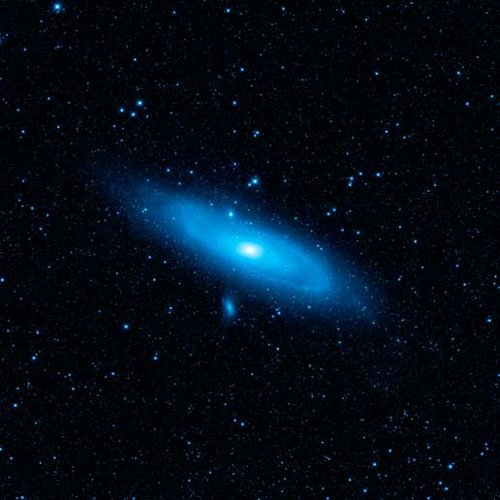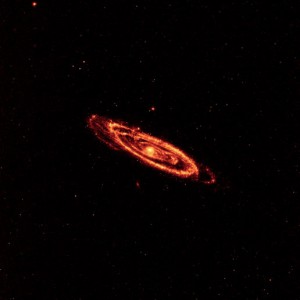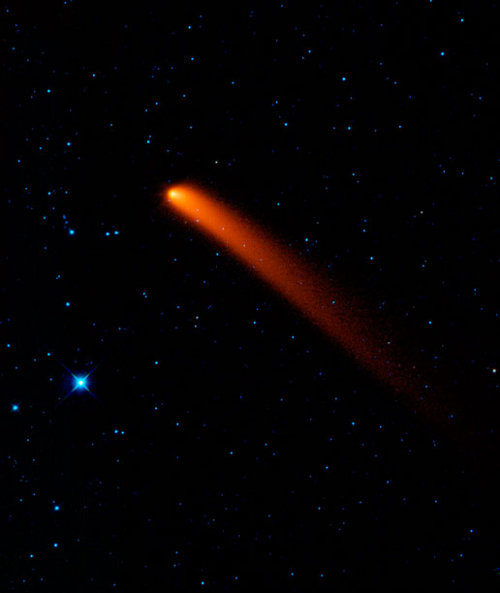We’re keeping a close eye on the WISE mission (Wide-field Infrared Survey Explorer) and the possibility of identifying brown dwarfs closer to our Sun than the Centauri stars. But WISE’s targets are numerous, and the early imagery coming back from the mission is promising indeed. To check out the capabilities of this space-based observatory, have a look at some of the new photos, which show M31, the Andromeda galaxy, at a variety of wavelengths. The first image was made with all four of WISE’s infrared detectors — the caption describes the color coding.
Image: The immense Andromeda galaxy, also known as Messier 31 or simply M31, is captured in full in this new image from NASA’s Wide-field Infrared Survey Explorer, or WISE. The mosaic covers an area equivalent to more than 100 full moons, or five degrees across the sky. WISE used all four of its infrared detectors to capture this picture (3.4- and 4.6-micron light is colored blue; 12-micron light is green; and 22-micron light is red). Blue highlights mature stars, while yellow and red show dust heated by newborn, massive stars. Credit: NASA/JPL-Caltech/WISE.
Notice the two satellite galaxies above Andromeda and to the left of center and also the blue M110 directly below the center of the spiral arms. Like our Milky Way with its Magellanic clouds, Andromeda has a number of these satellite galaxies gravitationally bound to it. Now compare this to Andromeda as seen by WISE’s shortest wavelength camera, where the disk takes on a modified, warped shape, doubtless the result of an ancient galactic interaction:
Image: This image from WISE highlights the Andromeda galaxy’s older stellar population in blue. It was taken by the shortest-wavelength camera on WISE, which detects infrared light of 3.4 microns. A pronounced warp in the disk of the galaxy, the aftermath of a collision with another galaxy, can be clearly seen in the spiral arm to the upper left side of the galaxy. Credit: NASA/JPL-Caltech/WISE.
And finally, note M31 as seen by the longest-wavelength detector aboard WISE. Here the spiral arms can be traced all the way to the center of the galaxy, outlined by the hot dust being heated by the formation of new stars, with star formation visible as well in the satellite galaxies M32 and M110.
Image: This image from WISE shows the dust that speckles the Andromeda galaxy’s spiral arms. It displays light seen by the longest-wavelength infrared detectors on WISE (12-micron light has been color coded orange, and 22-micron light, red). Credit: NASA/JPL-Caltech/WISE.
With capabilities like these, WISE’s discoveries not just far afield but in nearby space should be numerous, its targets ranging from asteroids and comets to the aforementioned brown dwarfs. Principal investigator Ned Wright (UCLA) calls the incoming imagery ‘a candy store of images coming down from space,’ and for good reason. Have a look below at the Siding Spring comet, which passed about 1.2 AU from the Earth and 2.25 AU from the Sun in October of last year. This interloper from the Oort Cloud, also called C/2007 Q3, is now leaving the inner regions of the system and heading back out to deep space.
Image: Astronomers will use these measurements to learn about the comet’s size, composition, reflectivity, and the size and makeup of the dust particles in its coma (the hazy cloud surrounding its nucleus) and its tail. WISE data on this and other comets will help unlock clues that lay within these icy time capsules, teaching us about our solar system’s evolution. In this image, 3.4-micron light is colored blue; 4.6-micron light is green; 12-micron light is orange; and 22-micron light is red. It was taken on Jan. 10, 2010. Credit: NASA/JPL-Caltech/UCLA.
That cometary tail, by the way, stretches about sixteen million kilometers. The mood around the WISE mission seems celebratory as these early images point to the spacecraft’s prowess. Says project scientist Peter Eisenhardt (JPL):
“All these pictures tell a story about our dusty origins and destiny. WISE sees dusty comets and rocky asteroids tracing the formation and evolution of our solar system. We can map thousands of forming and dying solar systems across our entire galaxy. We can see patterns of star formation across other galaxies, and waves of star-bursting galaxies in clusters millions of light years away.”
Tracking comets and asteroids is a secondary mission for WISE, but we’re learning that it’s a capable and sensitive observer of objects near and far. For those of us with a brown dwarf fixation, we should know much more about their numbers in nearby interstellar space by late this year, adding to our catalog of these objects as the whole-sky infrared sweep is concluded. WISE already has an asteroid under its belt, a near-Earth object discovered on January 12, and it will be scanning the sky one and a half times until October, when its coolant will run out.







Two questions just came to mind:
– at what IR wavelength would a typical brown dwarf be most luminous?
– what is the lowest magnitude object that WISE can ‘see’ at that wavelength?
The answers to these two questions could put a lower limit on the size of the BDs that can be detected and an upper limit on their distance.
Although my expectations are little, I’m hoping for a brown dwarf star in our outer solar system. Circling it in a close orbit I’m hoping for a water planet in a habitable zone just right for our ancestors habitation some day.
The odds for this are probably better than for a dollar lottery ticket.
Csaba T
This should answer your first question:
http://www.astro.cornell.edu/academics/courses/astro101/herter/lectures/lec09.htm
For your second question, the sensitivity of WISE can be found at
http://en.wikipedia.org/wiki/Wide-field_Infrared_Survey_Explorer.
Note that the sensitivity is given in units of Janskys, magnitudes are usually not used as units of measurement at wavelengths longer than a few microns.
See http://en.wikipedia.org/wiki/Jansky
Will WISE in fact pin down the IMF (initial mass function)– that is, what is the number of stars and brown dwarfs of different masses produced by the star formation star formation process.
I have heard that the IMF may actually vary from place to place across our Galaxy. Is this true? Also, I have heard that there is strong evidence that there may be as many brown dwarfs in our galaxy as there are stars of spectral type O, B, A, F, G, K, and M. If it is true that brown dwarfs out number stars, then it is likely WISE will find a brown dwarf closer to us than Alpha Centauri. All of what I have heard comes from press releases and/or papers I don’t remember the titles of. Sorry.
I would what the public reaction would be if it were to detect a brown dwarf or two closer than the centauri system. Would the public even notice if tomorrow 2-3 brown dwarfs were detected at a distance of 2-3 light years?
david : “I would what the public reaction would be if it were to detect a brown dwarf or two closer than the centauri system.”
Probably nothing, or at least nothing until several crazies jump up and claim that said object will crash into the Earth two years from now. Some people are very vague on the concepts of astronomical distance and volume and gravitation and…
Probably front page, under the heading ‘New Star Discovered Near Earth’, ‘Scientists Wrong: Closest Star Not Centnaturi’ or ‘Scientists Discover Closest Star To Earth’. Other headlines would be ‘Tanya in BB sex shock” :)
spaceman,
See http://arxiv.org/abs/astro-ph/0201098
regarding your question on the IMF. Whether
brown dwarfs out number stars is still unclear as the data is incomplete.
It is estimated that about half of the nearby stars
(say less than a few dozen light years), remain to be discovered.
The data on nearby brown dwarfs is even less complete.
//It is estimated that about half of the nearby stars
(say less than a few dozen light years), remain to be discovered.//
What are the chnaces, then, of finding one closer than Centuari, if that’s the case?